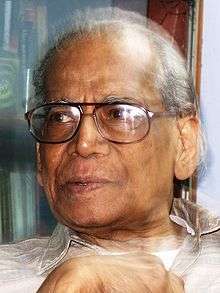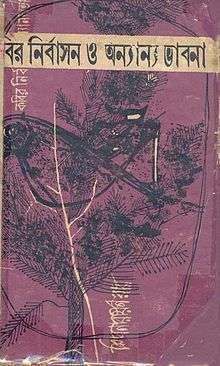Sibnarayan Ray

Sibnarayan Ray was a Bengali thinker, educationist, philosopher and literary critic of twentieth century India. A radical humanist, he is widely reputed for his works on Marxist-revolutionary Manabendra Nath Roy, and famous polymath Bertrand Russell, commenting on Ray, once said that "... Sibnarayan Ray stands for a point of view which I consider important in every part of the world. ... His writings ably represents a more reasonable point of view than that of most writers of our time."
Life and career
On 20 January 1921, Sibnarayan Ray was born to Professor Upendranath Bidyabhushan Shastri (1867–1959) and poet Rajkumari Roy (1882–1973) in Calcutta, India. His father was a thinker-writer who had published more than 50 books in Sanskrit and English. His mother too was a literary person who regularly contributed to magazines like Bamabodhini, Shibam, Antapur and Mahila.[1] Sibnarayan started writing in his teens. He graduated from the University of Calcutta with a degree in English language and literature. He was married to Gita Ray.
He joined the City College, Calcutta, a constituent undergraduate college of the University of Calcutta, in 1945 at the age of twenty four as a lecturer in English literature. He taught there for long fifteen years. He was reader and head of the Department of Indian Studies at the University of Melbourne from 1963 until late-1980.
Ray taught at many universities around the world as visiting professor, including the School of Oriental and African Studies (SOAS) under the University of London and the department of Social Science at the University of Chicago. He was invited to deliver lectures at many universities in France, Germany, Austria, Italy, the Netherlands, Denmark, Switzerland and Hungary. As a visiting professor he taught courses at Clare College of Cambridge University, Goethe University in Frankfurt and at Stanford University.
After returning to Calcutta from Melbourne, he worked as Director of the Rabindra Bhavan at Visva-Bharati University, from 1981 to 1983. He was an Emeritus Fellow on Literature of the Department of Culture, Government of India. Also he worked as the Chairman of the Raja Rammohan Roy and as Senior research Fellow at the Indian Council of Historical Research. Notably, he worked as the Executive Secretary of the Indian Renaissance Institute (IRI) from 1960 to 1969.
He died in Shantiniketan on 26 February 2008. Following his wishes, his mortal remains were donated to the SSKM Hospital in Calcutta.
A radical humanist
Ray was imbued with the spirit of communism in early life. However the realities of Stalinist rule in the USSR frustrated him. That led him to believe in the sublimity of humankind and made him aware of the constraints of human freedom that are inherent in man's own cognition. For his philosophical thinking he came to be known as a radical humanist. However, Sibnarayan Ray was profoundly influenced by the concept styled "Beyond Communism", propounded by M. N. Roy. The concept of radical humanism was conceived by M. N. Roy in his Basic principles of Radical Democracy, which he shared with a few comrades, including Sibnarayan Ray. One of the assumptions was that party-politics was inconsistent with his ideal of organised democracy. It was 'radical' because it rejected many of the traditional political and philosophical assumptions underlying the society of early twentieth century India; and it was 'humanism' because it focused entirely on the needs and situation of human beings.[2] Young Sibnarayan took part in the Radical Humanist Movement launched by M. N. Roy in 1948.[3] Notably, unlike some humanists, radical humanists aim to overthrow or transcend existing social arrangements. Radical humanists seek transformation, emancipation, and critical analysis of modes of domination. They want people to reconstruct their view of reality and take appropriate action. [4] Ray said that it was not just religion, but politics which could stifle free-thinking and the spirit of inquiry. The human mind has a conflict in itself. It will either give in to an authority or ask questions. He believed that in order for a society to thrive it should follow the latter path. However, Ray believed that today, both rationality and the questioning spirit are on the wane.[5]
Literary criticism
Sibnarayan Ray was highly respected for his literary criticism.
Publication of Jijnasa
He published and edited Jijnasa (Bengali: জিজ্ঞাসা) which became the most important Bengali journal of literature, history, culture and philosophy. Writers from home and abroad contributed to this Bengali language journal published from Calcutta. Professor Ray undertook to edit and publish Jijnasa in 1980 while he was still residing in Melbourne.[1]
Works on M. N. Roy
Indian revolutionary communist M. N. Roy was one of the pioneering leaders of the revolutionary movements in India, Mexico, the Soviet Union, and China. He took leading role in founding the Communist Party of Mexico (1919) and of India (1920). During the 1920s he rose to the highest echelon of the Communist International hierarchy by becoming a member of the Executive Committee, the Presidium and the Political Secretariat. More importantly he was reputed to be an unparalleled theorist with incisive and analytical writings. Sibnarayan Ray first met M. N. Roy in 1946. He was greatly influenced by the thinking of this revolutionary. Before his death he was writing a biography of Manabendra Nath Roy. He edited the works of Roy in four volumes which have been published by the Oxford University Press.[6]
Poetry
Sibnarayan Ray composed some poems in his early years of writing. Most of them were collected in an anthology under the title Kothara Tomar Mon, published in 1951. A second edition of the anthology was published in the late 1990s. One of these poems rendered into English from Bengali by Evelyn Panofsky is quoted below:[7]
This Rare Afternoon
This rare afternoon in the valley of autumn.
Behind the trembling curtain of pine needles
sad sun’s gold. On chestnut branches
scant whorls of mauve-tinted flowers.
Drowsy peace falling,
pine needles falling,
touch of elderly sadness in the valley of autumn.
No dark monsoon flashes of passion’s anguish
are in this autumn’s serene and elderly sadness.
Afternoon of falling needles. Look, there falls
a dew drop and glides down the curved belly of time.
Quotations
- In the whole world, it is only Goethe who compares with Rabindranath Tagore in terms of literary diversity.
- If Bengali as a language has any chance to flourish, that will be in Bangladesh and not in West Bengal.[8]
Publications

Ray has more than fifty titles to his credit including one book of poetry, starting with Prekshita, his first book published in 1945. His works have been translated into many languages. Some of the titles are given below :
- Prekshita (tr. Perspectives)(Its focus was decadence of modern English literature.)
- Moumachi-tantra
- Sahitya Chinta (tr. Thoughts on Literature), 1956.
- Kothara Tomar Mon (poetry)
- M. N. Roy Philosopher-Revolutionary, edited by Sibnarayan Ray, Calcutta, 1959.
- Nayoker Mrityu (tr. Death of the Hero), 1960.
- Probasher Journal (tr. Journal written while abroad)
- Radicalism
- I have seen Bengal's Face (ed.) 1973.
- Gandhi, India and the World (edited)
- Kobir Nirbashon O Onanyana Bhawna (tr. Expulsion of the Poet and Other Issues), 1973.
- In quest of freedom-A study of the life and works of M. N. Roy
- Between Renaissance and Revolution: Selected Essays
- From the Broken Nest to Visva-Bharati
- Khraiyer dike (tr. Uphill route), 1988.
- A New Renaissance.
- Swadesh, Swakal, Swajan (tr. Own land, Own time, Own people), 1996.
- Selected Works of M.N.Roy: Vol:4. 1932–1936, by Sibnarayan Ray
- Bengal Renaissance: The First Phase [9]
- The University of Man: The Message of Romain Rolland [10]
- Vietnam Seen from East and West[11]
- In Man's Own Image (co-author Ellen Roy)
Essays
- "Ideologies and the Alienated Writer" in Society and the Writer: Essays on Literature in Modern Asia, edited by Wang Gungwu, M. Guerrero, and D. Marr, pp. 221–37. Canberra: Research School of Pacific Studies, The Australian National University, 1981.
- "A literary revolution in India", Times Literaray Supplement, August 1957.
- "Decline of the Indian Intellectuals", Quest, Octo–Dec 1958.
- "Eastwinf Westwind", Soviet Survey, April–June 1959.
- "Saratchandra Chottopadhya", The Radical Humanist, 22 June 1952.
- "Ezra Pound and the Artists's Dilemma", The Radical Humanist, September 1952.
- "Ezra Pound", The Calcutta Review, May 1943.
- "Albert Camus", Quest, April–June 1960.
- The Sikh Movement, in A New Renaissance.
- "Shakespearian Variations on the Theme of Apartheid" by Sibnarayan Ray, in Calcutta Essays on Shakespeare, Ed. Amalendu Bose.
Awards and recognition
- 1942 Regina Guha Gold Medal, Calcutta University.
- Bertrand Russell commented that
... Sibnarayan Ray stands for a point of view which I consider important in every part of the world. ... His writings ably represents a more reasonable point of view than that of most writers of our time.[12]
- Poet Edith Sitwell said
It is my convinced opinion that Sibnarayan Ray is one of the few really important critics of our time. ... In this most remarkable book Explorations, doors are opened upon long vistas of beauty and of meaning. There is a nourishment for the mind and for the power of living upon every page....[12]
References
- 1 2 One Sibnarayan Ray
- ↑ M.N. Roy: Radical Humanist: Selected Writings, compiled by Innaiah Narisetti, Prometheus Books, ISBN 1-59102-141-3
- ↑ http://www.buddhiwadi.org/M.%20N.%20Roy.htm
- ↑ TERN-Radical Humanist View
- ↑ A question of faith
- ↑ OUP: UK General Catalogue
- ↑ http://members.aol.com/shabdaweb/trPoetry38.html
- ↑ A few personal words on Professor Sibnarayan Ray Faizul Latif Chowdhury
- ↑ Half.com / Books / Bengal Renaissance: The First Phase
- ↑ Sibnarayan Ray – The University of Man: The Message of Romain Rolland
- ↑ The View from Vietnam – The New York Review of Books
- 1 2 Back cover of Kobir Nirbashon O Onanyana Bhawna, 1973.